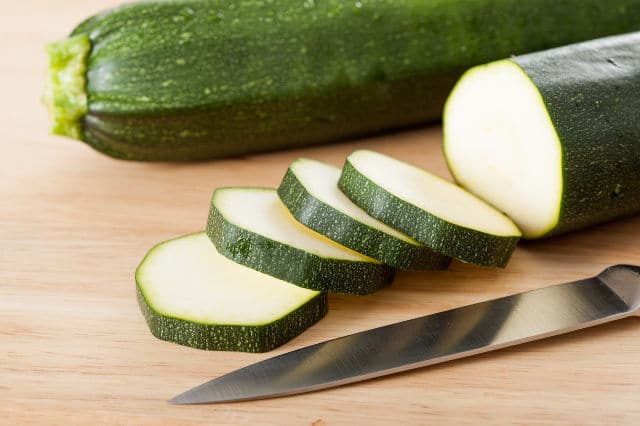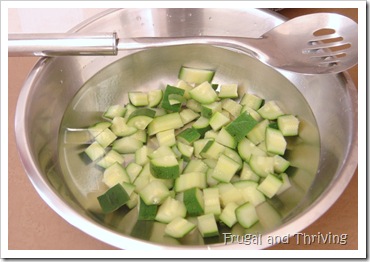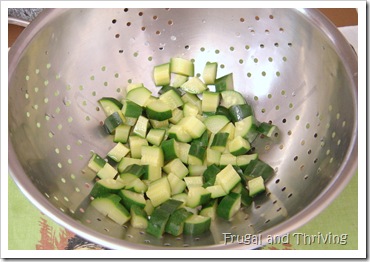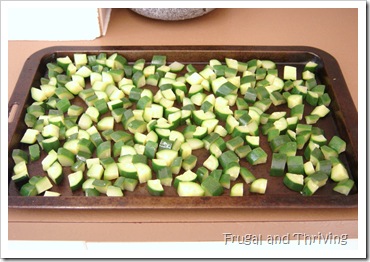How to Freeze Zucchini – A Step by Step Tutorial
This website may earn commissions from purchases made through links in this post.

The end of the zucchini season has seen an abundance of very cheap zucchini at our local greengrocer.
While we enjoy our zucchini, it doesn’t keep for very long in the crisper and buying it in 3kg lots can mean mushy, mouldy waste if we don’t freeze it or use it quickly.
Freezing zucchini is easy to do and means less chopping at meal times.
If you’re wanting to freeze an excess of zucchini, either bought or from your own harvest, here’s how to do it.
What you need:
- Pot for boiling zucchini
- A steamer that submerges in a pot or slotted spoon to remove zucchini
- Bowl of ice water (this will need to be refreshed for each batch)
- Colander or strainer for draining zucchini
- Clean tea towels for drying zucchini
- Tray or two that fits in your freezer for tray freezing zucchini
- Containers, jars or freezer bags to store frozen zucchini
- Masking tape and pen or similar for labelling frozen zucchini
the Steps
1. Wash your zucchini
Give the zucchinis a light wash to get rid of any dirt that may be attached. Some may need a very light scrub if there’s mud clinging to the skin.
2. Put a pot of water on to boil
To make this step quicker, you can boil the water in the kettle. I chop the zucchini while the water is coming to the boil.
3. Chop your zucchini as desired
You can cut the zucchini in rounds or dice or however you like. Keep in mind that the smaller you cut your zucchini, the less time it will need to be blanched.

If you would like to grate your zucchini instead, throw it in the food processor to make light work of the process, squeeze out extra moisture and then go straight to the tray freezing step – skip the blanching. Sprinkle the grated zucchini over the tray to avoid it freezing in big lumps. Once frozen, package, label and date.
4. Blanch
Place the zucchini in a pot of boiling water and bring back to the boil. Depending on how much zucchini you are processing or how big your pot is, you may want to do this in batches. It should only take a few seconds for the water to return to the boil.
Blanch the zucchini for 30 seconds to 1 minute, depending on the size you cut it. I blanched mine for about 30 seconds.
Blanching, by the way, kills off the enzymes that cause the vegetable to break down and discolour, even in the freezer.
5. Shock
Remove the zucchini from the boiling water and place it straight into the ice water. This is to stop the cooking process.
If you are using a steamer basket, don’t place the basket in the ice water as it will make the temperature of the ice water rise to much.

6. Drain and dry
Remove the zucchini from the ice water once cold and drain in a colander or strainer.

Zucchini tends to hold a lot of moisture so I dry it a little further by placing on a clean tea towel and very gently patting dry.

7. Tray Freeze
Place the zucchini in a single layer on a tray or several trays to freeze. This prevents the zucchini from freezing in a single lump.


8. Pack and label
Once the zucchini is frozen, package it in your desired container, label and date it.

How to use frozen zucchini
Boil or steam until desired tenderness like you would for any other frozen veg ie. don’t defrost. You will only need to cook frozen zucchini for a minute or less, it will be quite soggy otherwise.
You can also throw the frozen zucchini pieces into casseroles, soups, stir fries, curries etc.
Grated zucchini can be used in zucchini bread, fritters, nuggets, rissoles, meatloaf, veggie patties or your favourite zucchini recipe.







Does this method work for spiralized zuchini?
I don’t see why not. It might be a little soggy defrosted.
What about a rutabaga?
I had to look up rutabaga. We call them Swedish turnips here in Australia. It’s not something we eat a lot of, so I haven’t tried freezing it. Let me know if you give it a go.